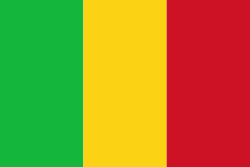Bamako (Bamako Region)
Bamako is the nation's administrative centre. The city proper is a cercle in its own right. Bamako's river port is located in nearby Koulikoro, along with a major regional trade and conference center. Bamako is the seventh-largest West African urban center after Lagos, Abidjan, Kano, Ibadan, Dakar, and Accra. Locally manufactured goods include textiles, processed meat, and metal goods as well as mining. Commercial fishing occurs on the Niger River.
The name Bamako (ߓߡߊ߬ߞߐ߬ Bàmakɔ̌ in Bambara) comes from the Bambara word meaning "crocodile river".
The area of the city has evidence of settlements since the Palaeolithic era. The fertile lands of the Niger River Valley provided the people with an abundant food supply and early kingdoms in the area grew wealthy as they established trade routes linking across west Africa, the Sahara, and leading to northern Africa and Europe. The early inhabitants traded gold, ivory, kola nuts, and salt. By the 11th century, the Empire of Ghana became the first kingdom to dominate the area.
The Mali Empire grew during the early Middle Ages and replaced Ghana as the dominant kingdom in west Africa, dominating Senegal, Gambia, Guinea, and Mauritania. In the 14th century, the Mali Empire became increasingly wealthy because of the trade of cotton, gold and salt. Bamako became a center of commerce and Islamic learning, but declined when Mali was overthrown by the Songhai.
The Scottish explorer Mungo Park visited Bamako in 1797 and 1806 during his exploration of the Niger River. He estimated that the city at the time held 6000 inhabitants, but it would decline in importance up until the French conquest in 1883 and Bamako being named the capital of French Sudan in 1908. A railroad connecting Bamako to Dakar was completed in 1923.
Mali gained independence from France in April 1960, and the Republic of Mali was later established. At this time, Bamako had a population of around 160,000. During the 1960s, the country became socialist and Bamako was subject to Soviet investment and influence. However, the economy declined as state enterprises collapsed and unrest was widespread. Eventually, Moussa Traoré led a successful coup and ruled Mali for 23 years. However his rule was characterised by severe droughts and poor government management and problems of food shortages.
In the late 1980s the people of Bamako and Mali campaigned for a free-market economy and multiparty democracy. In 1990, the National Congress for Democratic Initiative (Congrès National d'Initiative démocratique, CNID) was set up by the lawyer Mountaga Tall, and the Alliance for Democracy in Mali (Alliance pour la démocratie au Mali, ADEMA) by Abdramane Baba and historian Alpha Oumar Konaré. These with the Association des élèves et étudiants du Mali (AEEM) and the Association Malienne des Droits de l'Homme (AMDH) aimed to oust Moussa Traoré. Under the old constitution, all labor unions had to belong to one confederation, the National Union of Malian Workers (UNTM). When the leadership of the UNTM broke from the government in 1990, the opposition grew. Groups were driven by paycuts and layoffs in the government sector, and the Malian government acceding to pressure from international donors to privatise large swathes of the economy that had remained in public hands even after the overthrow of the socialist government in 1968. Students, even children, played an increasing role in the protest marches in Bamako, and homes and businesses of those associated with the regime were ransacked by crowds.
On 22 March 1991, a large-scale protest march in central Bamako was violently suppressed, with estimates of those killed reaching 300. Four days later, a military coup deposed Traoré. The Comité de Transition pour le Salut du Peuple was set up, headed by General Amadou Toumani Touré. Alpha Oumar Konari officially became president on 26 April 1992.
On 20 November 2015, two gunmen took 170 people hostage in the Radisson Blu hotel. Twenty-one people‚ including three Chinese businessmen were killed in the Bamako hotel attack along with the two gunmen during the seven-hour siege.
Map - Bamako (Bamako Region)
Map
Country - Mali
 |
|
| Flag of Mali | |
Present-day Mali was once part of three extremely powerful and wealthy West African empires that controlled trans-Saharan trade: the Ghana Empire (for which Ghana is named), the Mali Empire (for which Mali is named), and the Songhai Empire. At its peak in 1300, the Mali Empire was the wealthiest country in Africa, covering an area about twice the size of modern-day France and stretched to the west coast of the continent. Mali was also one of the wealthiest countries on earth, and its emperor at its zenith, Mansa Musa, is believed to be possibly the wealthiest individual in history. Besides being an economic powerhouse, medieval Mali was a centre of Islam, culture and knowledge, with Timbuktu becoming a renowned place of learning with its university, one of the oldest in the world still active. The expanding Songhai Empire absorbed the empire in 1468, followed by a Saadian army which defeated the Songhai in 1591. In the late 19th century, during the Scramble for Africa, France seized control of Mali, making it a part of French Sudan. French Sudan (then known as the Sudanese Republic) joined with Senegal in 1959, achieving independence in 1960 as the Mali Federation. Shortly thereafter, following Senegal's withdrawal from the federation, the Sudanese Republic declared itself the independent Republic of Mali. After a long period of one-party rule, a coup in 1991 led to the writing of a new constitution and the establishment of Mali as a democratic, multi-party state.
Currency / Language
| ISO | Currency | Symbol | Significant figures |
|---|---|---|---|
| XOF | West African CFA franc | Fr | 0 |
| ISO | Language |
|---|---|
| BM | Bambara language |
| FR | French language |















